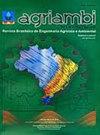巴西巴伊亚州发生可可念珠菌病风险的模糊建模
IF 1.4
4区 农林科学
Q3 AGRICULTURAL ENGINEERING
Revista Brasileira de Engenharia Agricola e Ambiental
Pub Date : 2020-04-01
DOI:10.1590/1807-1929/agriambi.v24n4p225-230
引用次数: 0
摘要
本研究旨在利用分布在巴西巴伊亚州的519个测量点的温度和空气相对湿度的历史数据集,利用模糊逻辑方法确定巴西巴伊亚州的可可moniliasis的潜在孳生区。数据最初提交给描述性统计分析。通过地统计学分析确定空间变异性,然后通过插值绘制该现象的时空结构依赖性。使用模糊映射对变量的连续像素到像素分类进行模拟,以模拟疾病建立的气候风险。温度数据采用指数模糊模型,空气相对湿度数据采用线性模型。每个月使用温度和空气相对湿度数据定义潜在区域。所使用的模糊模型允许对可可线虫病建立的气候风险进行建模。该州的大片地区是疾病的高危地区,因此需要采取缓解措施,以避免病原体的传入和传播。本文章由计算机程序翻译,如有差异,请以英文原文为准。
Fuzzy modeling of the risk of cacao moniliasis occurrence in Bahia state, Brazil
ABSTRACT This work aimed to determine potential areas for the establishment of cocoa moniliasis in Bahia state, Brazil, by means of fuzzy logic, based on historical datasets of temperature and air relative humidity, available for 519 measurement points distributed throughout the state of Bahia. The data were initially submitted to a descriptive statistical analysis. The spatial variability was determined through geostatistical analysis, followed by interpolation to map the spatial-temporal structure dependence of the phenomenon. Simulations of continuous pixel-to-pixel classification of variables were performed using fuzzy mapping to model the climatic risk of disease establishment. The exponential fuzzy model was applied to temperature data, while the linear model was used for air relative humidity data. The potential areas were defined for each month, using data of temperature and air relative humidity. The fuzzy models used allowed for modeling of the climatic risk of cocoa moniliasis establishment. A large area of the state is at high risk of disease, thus requiring mitigating measures to avoid the pathogen’s introduction and dissemination.
求助全文
通过发布文献求助,成功后即可免费获取论文全文。
去求助
来源期刊

Revista Brasileira de Engenharia Agricola e Ambiental
Agricultural and Biological Sciences-Agronomy and Crop Science
CiteScore
2.70
自引率
16.70%
发文量
114
审稿时长
3-8 weeks
期刊介绍:
A Revista Brasileira de Engenharia Agrícola e Ambiental (Agriambi), periódico oficial da Asociación Latinoamericana y del Caribe de Ingeniería Agrícola (ALIA), é editada mensalmente, no formato eletrônico, pela Unidade Acadêmica de Engenharia Agrícola (UAEA) do Centro de Tecnologia e Recursos Naturais (CTRN) da Universidade Federal de Campina Grande (UFCG), destinando-se à divulgação de artigos científicos originais e inéditos, elaborados em Português, Inglês ou Espanhol. Com o auxílio de pareceres de Consultores, os artigos são aceitos ou não pela Equipe Editorial para publicação na Revista. A Agriambi aceita, também, a submissão de contribuições na modalidade de revisão de literatura.
 求助内容:
求助内容: 应助结果提醒方式:
应助结果提醒方式:


